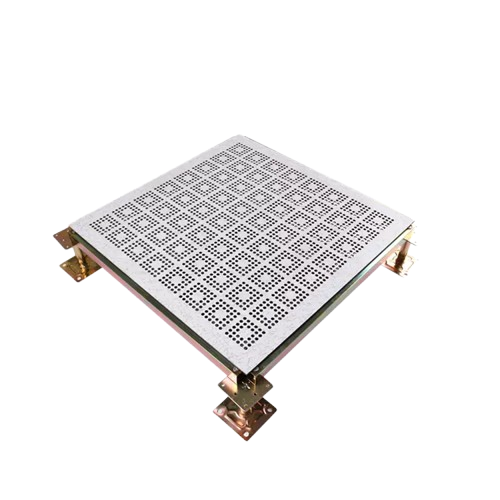Perforated steel raised floor system air flow panel
Detailed of perforated steel raised floor
Perforated steel raised floors are one of the most essential parts of a raised floor system in the data center, computer room, and other equipment rooms. Distributed air leakage usually represents a large percentage of the total airflow into the raised floor plenum, which means this not only wastes cooling but also more power required to cool equipment.
Too few perforated floors will result in air recirculation, while too many will increase bypass air.
Proper installation of perforated raised floors, panels and air flow tiles can make an obvious difference in the energy efficiency of raised floor systems.
Rate options of perforated steel raised floor
All steel perforated raised flooring is compatible with any bolted stringer Raised Floor systems and offer between 17% to 45% free airflow rate. Our all-steel perforated raised floor provides superior cooling for managing heat loads in mission-critical facilities to be available with top surface adjustable damper and it is the same size and finish as the solid panel, so they are ideal for High-Pressure Laminate, vinyl and rubber access floor coverings are available as well, Vinyl floor coverings interchangeable with woodcore panel/calcium sulphate perforated panel/tile.
22%Rate air flow panel
Damper types of perforated steel raised floor
Round damper for perforated steel raised floor
Sliding damper for perfprated steel raised floor
Opposite open damper for aluminum grate raised floor
Temperature control fan system for perforated steel raised floor
1.What is Temperature control fan system?
MAJET RAISED FLOOR Air boosted Power Fan Unit is designed to provide a blast of cooling through an individual directional airflow panel. The temperature controlled fan units are available quad fan models. The fan has multiple control options to automatically turn on when conditions require additional cooling . This powerful solution is ideal for solving the toughest hot spots in a data center.
2.Performance Characteristics
Zero maintenance
Installation can be carried out by IT staff
Multiple control options for both models available
VN – client sensor network·High Precision, Quick Response Temperature Measurement
User programmable set point
Viewable Peak Temp for walkthrough check of each rack
Infinitely variable fan speed from 0-100% for precise airflow control
Easily installs into either 24″ or 60cm raised floor systems
Fan Unit
Four-Fan Unit
Types of surface finish on perforated steel raised floor
1.HPL
2.PVC
Installation Process of perforated steel raised floor
Installing raised floors involves a systematic approach to ensure stability and functionality. The process includes preparing the subfloor, assembling the support structure, and securing the panels in place.
Step-by-Step Guide to Installing Raised Floors
Subfloor Preparation:
Ensure the subfloor is clean, level, and free from debris.
Grid Assembly:
Construct the support grid according to the design specifications.
Panel Installation:
Secure the panels onto the grid, ensuring a snug fit.
Finishing Touches:
Complete the installation with trim and edge pieces for a polished look.
Installation tools of raised floor
Raised floor electrical screwdriver
Raised floor hammer
Installation Vedio of laminated Steel Raised Floor
Features of perforated steel raised floor
Provide superior cooling for managing heat loads in mission critical facilities. Available with top surface adjustable dampers. The steel perforated panels are same size and finish as the solid panel, so they are available with High Pressure Laminates, Vinyl and rubber floor coverings interchangeable with woodcore panel/calcium sulphate panel.
1.Ventilation Efficiency
Perforated steel raised floor panels are designed with small holes or perforations that enhance ventilation within a space. This feature is particularly advantageous in data centers or offices where maintaining optimal temperatures is crucial for the performance of electronic equipment.
2.Structural Strength
The use of steel as the primary material ensures high structural strength. Perforated steel panels can withstand heavy loads, making them suitable for supporting not only office furniture but also heavy data center equipment, ensuring a stable and durable flooring solution.
3.Customizable Design
These panels offer flexibility in design with customizable perforation patterns. This allows for tailored solutions to meet specific ventilation requirements or cable management needs. The ability to adapt the design to the unique demands of a space adds to the versatility of perforated steel raised floor panels.
4.Cable Management
Perforated panels provide an efficient solution for managing cables and wires. The holes in the panels allow for organized routing of cables beneath the raised floor, reducing clutter and simplifying maintenance tasks.
5.Options for Static Dissipation
In environments where electrostatic discharge (ESD) is a concern, perforated steel panels can be designed to dissipate static electricity. This feature is essential for protecting sensitive electronic equipment from potential damage caused by static charges.
6.Easy Accessibility
The raised floor system featuring perforated steel panels allows easy access to the underlying infrastructure. This accessibility facilitates maintenance tasks, troubleshooting, and upgrades to electrical and data systems without major disruptions to the overall functionality of the space.
Production process of perforated steel raised floor
Process:Cutting-forming-welding-phosphating and spraying-filling cement-drying-laminated tiles
Related production of laminated steel raised floor
OA steel raised floor
Calcium sulphate raised floor
Woodcore raised floor
Aluminum raised floor
Laminated steel raised floor
Applications of perforated steel raised floor
Office
In modern office design, raised floors contribute to a clean and organized appearance while accommodating the complex wiring systems necessary for today’s technology-driven workplaces.
Data center
Data centers rely on raised floors to manage the extensive cabling required for servers and networking equipment. The improved airflow also helps in maintaining optimal temperatures for electronic components.
Cleanroom Environments
Industries with stringent cleanliness requirements, such as pharmaceuticals and biotechnology, utilize raised floors to create controlled environments free from dust and contaminants.
Educational Institutions
Schools and universities leverage the flexibility of raised floors to accommodate evolving technologies in classrooms and laboratories.
Comparison of different raised floors
NOTE:
1.Majet raised access floor has continuous product data improvement.It reserves the right to change type design and specifications without notice.
2.A—Most advantage,E—Least advantage
3.The comparison is based on the raised access floor panels of same concentrated loading grade.
Comparison of different raised floor downlaod
Our company about raised floor
MAJET raised floor is a leading manufacturer and exporter in China, supplying raised floor system, data center products, underfloor air conditioning and underfloor wiring. We have over 60,000 square meters plant and 200 workers and over 35 years experience in industry.
Majet raised floor caltalogue download
Quality control of perforated steel raised floor
Concentrate loading test
Coating thickness test
Flatness test
Salt-spray test
Certificates of Majet raised floor
Exhibition of Majet raised floor
Advantages of perforated Steel Raised Floors
Improved Airflow and Ventilation
One of the primary benefits of raised floors is the enhanced airflow and ventilation they offer. This is particularly crucial in environments with sensitive electronic equipment, such as data centers.
Accessibility for Cabling and Utilities
Raised floors provide a concealed space for the installation and maintenance of cabling, electrical wiring, and plumbing. This accessibility simplifies upgrades and repairs, reducing downtime.
Enhanced Flexibility in Space Usage
The modular nature of raised floors allows for easy reconfiguration of interior spaces. This adaptability is especially valuable in office settings where layouts may need frequent adjustments.
How to maintain raised floor?
In order to get better use results and extend the service life of the raised floor, correct daily cleaning and maintenance are important.
1.Carefully read the use and maintenance instructions
Provided by the raised floor manufacturer and follow them. Floors made of different materials may have different maintenance methods.
2.Use shoe covers and foot pads
Placing floor mats at the door of the room can effectively reduce dust and debris from being brought into the room, reducing the frequency of cleaning of the raised floor.
If possible, you can use protective tools such as shoe covers to reduce dust and debris and reduce the scratching of the soles on the floor. Especially helpful for the maintenance of PVC veneer.
3.Prevent overloading
Please do not place particularly heavy furniture or equipment directly on the raised floor. You can use a load-bearing base to distribute the weight, or use other means of proper load distribution.
4.Clean regularly
During use, the raised floor needs to be cleaned regularly depending on the use environment. You can use a soft-bristled brush or vacuum cleaner to remove dust and debris from the surface to reduce particles from repeatedly scratching the floor.
When necessary, the floor needs to be deep cleaned to remove stubborn stains. Be careful not to use harsh chemicals or abrasive cleaners as they can cause damage to the floor. It is recommended to use professional floor cleaners.
5.Anti-static finish
When the floor uses an anti-static finish, its anti-static performance needs to be tested regularly.
6.Leakage problem
If the raised floor is used in an area prone to leaks or spills, please check regularly for leaks. Water can cause damage to the raised floor and supporting structures, so leaks need to be resolved promptly.
7.Professional inspection
Regularly check the situation of your raised floor. If there is damage, such as loose tiles, damaged edges or corrosion of accessories, it needs to be repaired in time. If it cannot be repaired, please replace the bad parts.
FAQs of perforated steel raised floor
Q1.Why Choose perforated Steel Raised Floor?
1.Flexibility and Customization
One of the primary reasons architects and builders are turning to steel raised floors is their unparalleled flexibility. These floors allow for easy customization to meet the specific needs of a space, making them ideal for environments with evolving requirements, such as office spaces.
2.Accessibility and Maintenance
The space beneath steel raised floors, known as the plenum, serves as a concealed pathway for cables, electrical wiring, and ventilation systems. This not only streamlines the aesthetic appeal of the space but also facilitates easy access for maintenance and upgrades, minimizing downtime.
3.Improved Indoor Air Quality
Steel raised floors contribute to better indoor air quality by promoting efficient air circulation. The plenum acts as a channel for air movement, reducing the risk of stagnant air and fostering a healthier environment, particularly crucial in spaces like data centers.
4.Versatility in Applications
Whether it’s an office, data center, cleanroom, or laboratory, steel raised floors adapt seamlessly to various applications. Their versatility makes them a preferred choice in diverse industries where the need for adaptable and functional spaces is paramount.
In essence, steel raised floors serve as a foundation for innovation in design and functionality, offering a dynamic solution that addresses the evolving demands of modern architecture.
Q2.How Steel Raised Floor Compare to Traditional Flooring?
In the fourth part of our series on steel raised floors, we embark on a comparative analysis, pitting these innovative flooring solutions against traditional alternatives. By examining factors such as installation, maintenance, and adaptability, we aim to showcase the distinct advantages that set steel raised floors apart.
1. Installation Process: Speed and Efficiency
When it comes to the installation process, steel raised floors stand out for their speed and efficiency. Traditional flooring methods often involve time-consuming processes, including the curing of adhesives and setting times for materials. In contrast, steel raised floors, with their modular design, can be installed more swiftly, minimizing construction timelines and reducing associated costs.
2. Flexibility and Customization
One of the defining features of steel raised floors is their flexibility and customization capabilities. Traditional flooring methods, such as glued-down carpeting or hardwood, lack the adaptability needed for dynamic environments. Steel raised floors, with their modular panels, allow for easy reconfiguration to meet changing needs, providing a level of versatility unmatched by traditional alternatives.
3. Accessibility for Maintenance and Upgrades
Maintenance considerations play a crucial role in flooring choices. Traditional flooring, when damaged or requiring maintenance, often involves extensive and intrusive procedures. Steel raised floors, on the other hand, excel in this aspect. The plenum space beneath allows for easy access to underlying infrastructure, simplifying maintenance procedures and reducing downtime.
4. Cost Considerations and Long-Term Savings
While the initial cost of steel raised floors may seem higher than some traditional flooring options, it’s essential to consider the long-term savings they offer. The efficiency of installation, reduced maintenance costs, and adaptability contribute to a higher return on investment over the life of the building.
5. Environmental Impact
In an era where sustainability is a top priority, the environmental impact of flooring choices cannot be overlooked. Traditional flooring materials may involve adhesives and finishes with volatile organic compounds (VOCs), contributing to indoor air pollution. Steel raised floors, with their focus on improved indoor air quality, align with sustainable building practices.
This comparative analysis underscores the distinct advantages of steel raised floors over traditional flooring methods, positioning them as a forward-thinking and practical choice for modern construction and design.
FAQs of factory raised floor
Q1.What is your MOQ?
A: 100pieces each type
Q2.What is the loading quantity in one 20GP?
A:1100-1500pieces,depending on the raised floor type.
Q3.When is your delivery time?
A: 30days after receiving the prepayment.
Q4.What is your package?
A:packed in wooden pallet,covered with plastic film.
Q5.What is your payment term?
A:T/T,L/C,Western Union.





